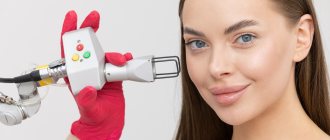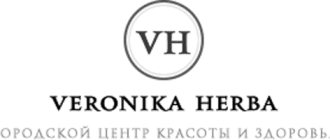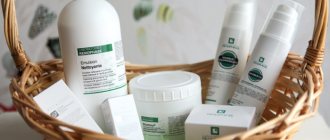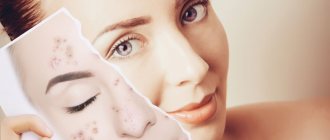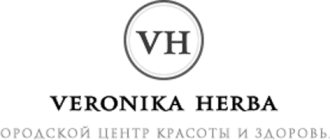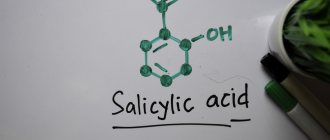From this article you will learn:
- Indications for laser peeling
- Types of laser peeling for the face for wrinkles and other skin problems
- Pros and cons of skin rejuvenation using laser peeling
- 3 stages of laser peeling
- Skin care after laser peeling
- Frequently asked questions about the laser peeling procedure
Laser peeling helps to effectively combat age-related changes in the skin, as if erasing several years from the face. The stratum corneum, which is actually responsible for the appearance of wrinkles, is destroyed by laser during the procedure. The method is also indicated against age spots, acne scars, scars and other minor skin irregularities.
Despite the fact that the depth of beam penetration is adjusted individually based on the problems of a particular patient, many are still wary of laser procedures. The irrational fear of burns makes women refuse the possibility of real rejuvenation. We will dispel fears about laser peeling and tell you in detail about this wonderful and completely safe technique that will help you restore freshness and beauty to your skin.
Indications for laser peeling
The essence of the hardware technique, called laser peeling (resurfacing, dermabrasion), is that under the influence of a laser beam, controlled damage to the epidermis occurs in order to start the process of skin renewal. During the procedure, due to the strong heating of the skin surface, some of its layers evaporate.
Laser peeling is a professional cosmetic procedure that gives a noticeable effect in the fight against imperfections and skin problems that are much worse dealt with by other methods. The face literally transforms after laser peeling. Moreover, the depth of exposure can be adjusted, focusing on the severity of skin flaws and their localization.
Using this procedure you can get rid of:
- scars and stagnant spots formed due to acne;
- scars and stretch marks (all over the body);
- sagging facial skin and wrinkles on it;
- sagging and thinning of the skin of the eyelids.
Laser peeling will be useful in the following cases:
- uneven skin texture;
- there are pigment spots on the face;
- too enlarged pores on the skin;
- dull complexion, lack of skin tone;
- there are milia;
- hyperkeratosis is observed.
Pigmentation remover
Another area of use of athermal laser is the removal of skin pigmentation. The laser beam acts selectively - only on those cells in which there is an excess of melanin. Normal cells are “invisible” to the beam, so it does not affect them.
During the procedure, the following are removed:
- Freckles;
- Solar pigmentation;
- Age-related pigmentation.
The treated surface soon after the procedure darkens and begins to peel off. After 5-10 days, the pigmentation disappears. As a rule, the procedure must be repeated. On average, 2-4 procedures are required to achieve clear skin.
Positive reviews about laser pigmentation removal confirm its effectiveness.
Types of laser peeling for the face for wrinkles and other skin problems
- Cold laser peeling
This is what is commonly called superficial laser peeling, which does not heat the deep layers of the epidermis and does not affect the dermis. It evens out skin texture and tone well. After a course of superficial peeling, she looks smooth and radiant - the effect of the procedure is similar to acid peeling, which visually rejuvenates the face.
Before the procedure, local anesthesia is required (a special anesthetic cream is applied to the skin). Complete exfoliation occurs in 2–3 days. There is no severe swelling.
- Hot laser peeling
The technique involves influencing at a deeper level, which also affects the effect - it is more pronounced and comparable to medium acid peeling.
Deep laser peeling can be carried out with different types of devices - fractional and standard. The second type is more traumatic; in this case, the laser beam damages the entire skin, making several passes and evaporating the epidermis layer by layer. The dermal layer also warms up, which helps stimulate the production of protein structures.
A deeper effect on the skin makes the painful sensations stronger. Rehabilitation is not quick or easy. Swelling persists for several days, the face is covered with crusts that disappear for at least a week. But after healing, the rejuvenating effect is impressive: the skin texture is evened out, it is noticeably tightened, it becomes more elastic and firm.
- Fractional laser peeling
This procedure is much easier to tolerate than the previous one, and recovery after it is easier, because during laser exposure the skin is not completely damaged. Between the areas heated by the laser, there are microscopic zones that are not affected by the laser. Fractional laser peeling can be either cold or hot - the method allows for exposure at different levels.
You can also find another name for this peeling – laser photothermolysis. The advantage of a fractional laser compared to a traditional one is its targeted effect. During photothermolysis, the laser beam breaks up into a mass of very thin beams. The impact on the skin occurs from the superficial to deep layers. Nevertheless, the tissues are damaged fragmentarily and in doses, and there are untouched gaps between the injured areas, so rehabilitation does not take much time and causes virtually no discomfort. The procedure itself does not cause pain either.
It takes about five days for the microscopic crusts to disappear. You can see the result within a week. And although many are satisfied with the effect after the first procedure, it is recommended to complete a course (3-4 sessions) so that the skin is completely renewed.
Recommended articles on the topic:
- Ultrasonic facial peeling is a pleasant and beneficial procedure for your skin
- Redermalization of the skin: all the pros and cons
- Almond peeling for the face: features of the procedure
- Carbon laser peeling
Laser carbon peeling is a new procedure, it is aimed at deep cleansing the skin, is effective and painless. In another way, this peeling is called carbon cleaning. It is used if the skin is acne-prone or too oily. At the first stage, a mask with carbon dioxide (CO2) is applied to the face; laser peeling is done directly at the second stage, when the mask has dried.
How it goes
- The fractional laser peeling procedure is performed using an anesthetic cream.
- After a preliminary conversation with the patient about existing problems and studying the characteristics of his skin, the doctor performs makeup removal.
- An anesthetic is applied to cleansed skin and left for 40-60 minutes.
- The patient protects his eyes with glasses.
- The doctor selects the laser exposure parameters, removes the anesthetic, applies a lubricating cream and begins Fraxel peeling.
- When the manipulator touches the skin, fractional destruction of defective cells occurs, the patient feels warmth and a slight burning sensation.
- Facial treatment lasts on average 20-30 minutes.
- 20-30% of the skin surface is treated in one session
Pros and cons of skin rejuvenation using laser peeling
What laser peeling can do:
- restores elasticity to the skin and tightens the oval of the face;
- removes pigmentation, scars, scars, moles, eliminates stretch marks and other blemishes;
- reduces deep wrinkles on the forehead, in the corners of the eyes, near the lips;
- tightens pores and makes rosacea less pronounced;
- makes the complexion more even and beautiful.
Laser peeling can also be used on certain areas of the body, showing high results after the first session.
The disadvantages of the procedure include:
- Painful sensations. They arise due to the strong heating of the skin during laser treatment.
- Long rehabilitation period. Recovery after laser peeling takes up to 10–14 days.
- Adverse reactions and possible complications. After the session, the face becomes red. The intensity of the shade does not decrease immediately, but over several days. Hyperemia and swelling often occur as a result of laser exposure; antibiotics (in the form of ointments) may be needed during the rehabilitation process.
- Exfoliation of the top layer of skin. The laser beam destroys intercellular connections in the stratum corneum of the epidermis. Some time after the session, dead particles peel off, and in the deeper layers accelerated cell division and renewal of the epidermis occurs. That's why crusts form on the face first, and then the skin begins to peel off in whole pieces.
- Expensive. Compared to other anti-aging procedures and cleansing, laser facial peeling has a higher cost.
In some situations, you will have to refrain from this type of exposure to the skin so as not to cause harm to your health. Laser peeling has the following contraindications:
- presence of cancer;
- epilepsy attacks;
- fever and inflammation;
- diseases of the circulatory system;
- diabetes;
- severe chronic diseases;
- presence of a pacemaker;
- all trimesters of pregnancy and breastfeeding.
Rehabilitation
There is no recovery required after a non-traumatic procedure. The face may turn pink and peel slightly - these are normal phenomena that disappear within a day. In general, the skin looks good, so you can return to your normal lifestyle immediately after peeling.
In the first days after exposure, you should take good care of yourself, avoiding the use of aggressive agents. It is better not to overuse decorative cosmetics. It is imperative to protect your face from the sun: even on cloudy days, it is advisable to use products with SPF. Finally, for the first time after peeling, you should avoid thermal procedures (visiting a bathhouse, sauna, taking hot baths), as well as swimming in a pool or open water.
After peeling, all kinds of masks are especially effective, including homemade ones. A cosmetologist will help you choose the right products.
After a course of peeling, the face becomes young, smooth, and radiant. Pigmentation disappears, the relief is evened out, and the greasy shine disappears.
The effect is noticeable immediately, then it increases from one session to another. In most cases, a short course is enough to get closer to the ideal - to make the skin soft, smooth, “porcelain-like.”
Skin care after laser peeling
At the end of the procedure, the skin looks inflamed: it becomes red, serous fluid is released and the surface temperature of the tissue increases. As a result of laser exposure, brown spots and red dots often appear on the face. During the first day, swelling increases, wrinkles, scars and other skin imperfections become more noticeable.
Over the course of the next week, crusts will form on the skin. They need to be looked after properly. In about two weeks, the injured tissue will heal. Although the redness will remain for about the same time. The result of laser peeling depends on the type of treatment and the patient’s lifestyle. The duration of the effect is from 6 months to 1 year.
How to care for your skin during the rehabilitation period:
- if the laser peeling was deep, it is necessary to apply sterile gauze bandages or meshes soaked in Vaseline; the bandages must be changed every 3 hours;
- to reduce swelling, ice wrapped in a cloth or cold packs should be applied over the bandage several times a day;
- to soften the crusts and get rid of the ichor, apply napkins soaked in a vinegar solution (1 glass of water, 1 tablespoon of white vinegar) to the skin for 5 minutes; the need for the procedure disappears after the wounds stop bleeding and the crusts come off easily;
- after compresses, the skin surface should be treated with Chlorhexidine solution; it is forbidden to wash your face with cosmetic gels, foams, etc.;
- to get rid of pain, they take Tempalgin and similar drugs; often, in order to prevent complications, doctors prescribe broad-spectrum antibacterial agents, the course of such therapy is up to 10 days;
- for sleeping, it is recommended to use a high pillow, so that the head and upper chest are higher than the rest of the body; sleeping is only allowed on the back;
- During the first week after laser peeling, it is forbidden to rub your face, apply makeup, or use care cosmetics that contain aggressive components; if possible, it is better to stay at home;
- in the second week you can go outside, but first apply sunscreen moisturizer to your skin;
- after 3–4 weeks, it is recommended to visit a cosmetologist who will evaluate the effect of the procedure; at this time, you can enhance the result with biorevitalization or mesotherapy and set a date for the next laser peeling session;
- until the course of procedures has been completed, and for another 2 months after the final one, it is recommended to refrain from tanning.
Those who decide to undergo a laser peeling course should be prepared for such consequences as prolonged rehabilitation and discomfort during the recovery period. But these unpleasant moments are quickly forgotten when the effect of the procedure is fully manifested.
To consolidate the result, you can additionally carry out ozone therapy, plasma lifting, and mesotherapy.
High tech
Peels are an important part of skin care. The procedure involves removing dead skin cells from the epidermis. With age, regeneration processes slow down, and the skin needs to be helped to get rid of such cells. This can be done in different ways. Mechanical peelings involve grinding the upper layer of the epidermis (for example, using scrubs). Chemical burns are a controlled burn with acids, leading to exfoliation of the stratum corneum. For carbon fiber, laser radiation is used in combination with a special gel.
This combined effect not only exfoliates the top layer of the epidermis, but also cleanses the pores. This type of treatment is considered the most gentle, and, unlike most chemical peels, carbon peeling can be done at any time of the year, including summer.
The procedure is based on the interaction of carbon nanogel with neodymium laser radiation. First, a gel containing tiny particles of carbon dioxide is applied to the face. Activated carbon is famous for its ability to attract and bind toxins. Carbon gel works on approximately the same principle. Nanoparticles penetrate deeply into the epidermis, intensively absorbing skin secretions and impurities.
After this, a laser with a wavelength of 1064 nm comes into play. Under the influence of short pulses of radiation, the deep layers of the skin heat up. This process is called laser photothermolysis.
At the same time, the synthesis of collagen and elastin is activated, regenerative processes are accelerated, cellular metabolism is improved and pathogenic microflora is destroyed.
The heating is very short-lived, so burns are impossible, and there are no unpleasant sensations during carbon peeling. There is no need to use anesthesia.
Thanks to the targeted action of 1064 nm laser radiation, the carbon particles heat up more than the surrounding tissue.
Micro-explosions occur, leading to exfoliation of dead cells and cleansing of pores. Contaminants are literally pushed to the surface. Although the description of the process may seem scary, in fact the procedure is completely painless: the carbon particles are so small that the skin is not injured when they heat up and explode. Only dead cells are removed, making it difficult for the skin to breathe and worsening the complexion (a study on how beneficial carbon peeling is for acne).
Since carbon peeling requires special, expensive equipment and medical knowledge, it is best to do it in a clinic with a cosmetologist.
Although a gel with carbon nanoparticles is commercially available, there is no point in buying it for home use: without exposure to a neodymium laser, it will not be possible to achieve the desired effect. Advertising self-use gels is simply a slick marketing ploy. Without a laser, such products will be no more effective than the well-known (and much cheaper) cleansing masks.
Frequently asked questions about the laser peeling procedure
How many times should laser peeling be done?
To obtain a lasting effect, a course of procedures (from 2 to 8) is recommended. The interval between them is usually one to two months.
What is the price of laser facial peeling?
The cost of the service is determined depending on factors such as the depth of penetration of laser energy, the area of impact, the functionality of the equipment, the use of anesthetics and additional cosmetics. Different types of peeling can cost from 5 thousand rubles to 40 thousand. The most expensive procedure is one that includes treatment of the face and décolleté. The cosmetologist can make a specific calculation after the therapy program has been determined.
Contraindications:
- herpes;
- oncology;
- chronic diseases: diabetes mellitus, circulatory and blood clotting disorders, etc.;
- psoriasis;
- active infectious diseases;
- allergy;
- epilepsy;
- pregnancy and lactation period.
Try an alternative plastic surgery method to create a youthful look! Doctors at our center will select the optimal method for you. Sign up for laser resurfacing and fractional rejuvenation in Minsk at affordable prices at Idealmed +375 (17) 395-55-77, +375 (29) 144-22-22.
But what to do when it comes to atrophic skin scars?
After all, atrophic scars arise as a result of a reduced response of connective tissue to injury, as a result of which insufficient collagen is formed. The study by Tay and Kwok (2008) involved 150 volunteers with three types of atrophic scars: V-shaped, M-shaped, U-shaped, and compared the effectiveness of CO2 and erbium resurfacing when working with them. Patients who underwent erbium laser resurfacing showed improvement in U-shaped scars in 52.9% of cases, M-shaped scars in 43.1% of cases, V-shaped scars in 25.9% of cases, while As with the CO2 laser, there was a 23.3% improvement in U-shaped, 15% improved in M-shaped, 17.7% improved in V-shaped, and the erbium laser is now the standard in the treatment of atrophic skin scars.
Erbium lasers have now become the standard in the treatment of atrophic skin scars!
In my medical practice, I use two laser systems:
- Eraser C-RF (CO2 laser, 10,600 nm)
- Lotus II (Er:YAG laser, 2940 nm)
The Eraser C-RF CO2 laser system has a wide range of parameters, which allows you to create individual protocols for each patient. Possibility of additional connection of gynecological and ENT instruments, without “upgrading” the device and without switching scanners. The Coherent tube (metal, double welded and vacuum) makes the laser system indefinite. A unique ability to work in stack mode (up to 50 stacks), forming an ordered factional zone in the “rain” mode by chaotic feeding in a stable mode. This function allows you to gently treat the area without the use of topical anesthesia.
Video of the CO2 laser resurfacing procedure using the Eraser-C-RF device
The modern erbium laser system Lotus II (LaserOptek, South Korea) allows for both “cold and ultra-cold” and “hot” laser grinding, close to CO2 laser systems. All this is possible thanks to the choice of pulse duration from ultra-short - 40 μs ("cold" grinding), with virtually no period of desocialization and rehabilitation ("weekend grinding"), to an ultra-long pulse with a duration of 5000 μs ("hot grinding"). Moreover, in addition to the registration certificate of Roszdravnadzor, the Lotus II device has FDA approval, which proves its widespread use in the US and European markets. The device has a number of advantages:
- Lens thermal compensator
- Flat beam profile
- Lamp life 10 million pulses
- The presence of several attachments for removing tumors, fractional resurfacing, a set of gynecological attachments
